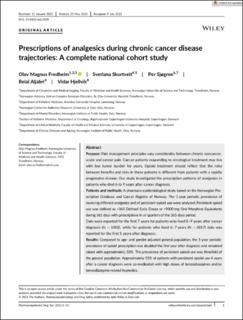| dc.contributor.author | Fredheim, Olav Magnus | |
| dc.contributor.author | Skurtveit, Svetlana Ondrasova | |
| dc.contributor.author | Sjøgren, Per | |
| dc.contributor.author | Aljabri, Belal | |
| dc.contributor.author | Hjellvik, Vidar | |
| dc.date.accessioned | 2021-10-08T07:00:47Z | |
| dc.date.available | 2021-10-08T07:00:47Z | |
| dc.date.created | 2021-08-17T09:49:56Z | |
| dc.date.issued | 2021 | |
| dc.identifier.citation | Pharmacoepidemiology and Drug Safety. 2021, 1-10. | en_US |
| dc.identifier.issn | 1053-8569 | |
| dc.identifier.uri | https://hdl.handle.net/11250/2788577 | |
| dc.description.abstract | Purpose Pain management principles vary considerably between chronic noncancer, acute and cancer pain. Cancer patients responding to oncological treatment may live with low tumor burden for years. Opioid treatment should reflect that the ratio between benefits and risks in these patients is different from patients with a rapidly progressive disease. Our study investigated the prescription patterns of analgesics in patients who died 6 to 9 years after cancer diagnosis. Patients and methods A pharmaco-epidemiological study based on the Norwegian Prescription Database and Cancer Registry of Norway. The 1-year periodic prevalence of receiving different analgesics and of persistent opioid use were analyzed. Persistent opioid use was defined as >365 Defined Daily Doses or >9000 mg Oral Morphine Equivalents during 365 days with prescriptions in all quarters of the 365 days period. Data were reported for the first 7 years for patients who lived 8–9 years after cancer diagnosis (N = 1502), while for patients who lived 6–7 years (N = 3817) data was reported for the first 5 years after diagnosis. Results Compared to age- and gender adjusted general population, the 1-year periodic prevalence of opioid prescription was doubled the first year after diagnosis and remained raised with approximately 50%. The prevalence of persistent opioid use was threefold of the general population. Approximately 55% of patients with persistent opioid use 4 years after a cancer diagnosis were co-medicated with high doses of benzodiazepines and/or benzodiazepine-related hypnotics. Conclusion The findings of increased opioid use raise concerns regarding whether the benefits outweigh risks and side effects in this population. | en_US |
| dc.language.iso | eng | en_US |
| dc.publisher | Wiley | en_US |
| dc.rights | Attribution-NonCommercial-NoDerivatives 4.0 Internasjonal | * |
| dc.rights.uri | http://creativecommons.org/licenses/by-nc-nd/4.0/deed.no | * |
| dc.title | Prescriptions of analgesics during chronic cancer disease trajectories: A complete national cohort study | en_US |
| dc.type | Journal article | en_US |
| dc.type | Peer reviewed | en_US |
| dc.description.version | publishedVersion | en_US |
| dc.source.pagenumber | 1-10 | en_US |
| dc.source.journal | Pharmacoepidemiology and Drug Safety | en_US |
| dc.identifier.doi | 10.1002/pds.5329 | |
| dc.identifier.cristin | 1926535 | |
| cristin.ispublished | true | |
| cristin.fulltext | original | |
| cristin.qualitycode | 2 | |

